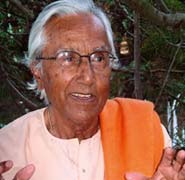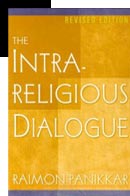

site officiel


Intrareligious Dialogue
As often occurs in Panikkar’s works, the book is preceded by several different prefaces succeeding each other in time and bearing witness to the constant endeavor to update and revise his opus.
This particular work presents a methodological outline for dialogue, with its openness and “in progress” approach. The first chapter, “The Rhetoric of Dialogue” analyses four attitudes of dialogue (exclusivism, inclusivism, parallelism and inter-penetration) and describes four models (geographical, physical, geometrical and anthropological) which give rise to a condensed and lively picture of the reality of dialogue. At the same time it provides an educational guideline for dialogue, for which there is such an great and urgent need.
The starting point of the third chapter, “Faith and Belief: a Multi-religious Experience”, is the Author’s own experience, which he has described as follows: “I started out as a Christian, “discovered” that I was a Hindu and then “went back” to being a Buddhist without ever having stopped being a Christian”. This chapter touches on issues of fundamental importance not only for dialogue among people of different religious faiths but also for the existential journey of anyone who considers him or herself to be religious. It stresses in particular the fact that authentic dialogue obliges one to examine contradictions that a monocultural and monolithic vision tends to ignore, first and foremost universality and concreteness, in other words how to experience concrete relationships with (seen as a notion embracing the totality of life), without grabbing hold of it as if one owned it exclusively. This leads us to consider the issue of the relationship between faith and belief a core problem. Panikkar writes: “Faith cannot be brought down to the same level as belief but in order to be faith it nevertheless needs belief”. Faith without belief becomes disembodied and ineffective, beliefs without faith degenerate into superstition and identifying belief with faith leads to idolatry.
The fourth chapter, “The Rules of the Game in Encounters between Religions” traces the structure of an epistemology of dialogue which Panikkar has developed ceaselessly throughout all his subsequent works.
The fourth chapter, “Epoche in the Encounter between Religions”, reaches the heart of the problem. According to the Author, Husserlian phenomenological epoche (the suspension of judgment) cannot be applied to the field of inter-religious dialogue. When encountering the other I cannot simply suspend my faith as if I did not believe in what I do believe in, because it is my very faith which sustains me in the actual dialogue. The religious nature of the dialogue means that I need a religious phenomenology so as to be able to meet the other on the same level, which is that of faith, not of knowledge. This inconceivable yet essential openness transforms inter-religious dialogue into intra-religious dialogue, that is to say an encounter with and between the religious inner selves of the parties to the dialogue, the outcome of which is quite unforeseeable.
In the sixth chapter, “The Category of Growth in Comparative Religion: a self-critical Approach”, Panikkar responds to some harsh criticism on the part of Catholic thinkers regarding his approach to dialogue by introducing the category of “growth” of religions through dialogue. Religions are not closed phenomena as explained by theology. Rather, they are living, vital and constantly growing organisms: encounters and dialogue are what feed this development.
Finally, in the nineth chapter, “Shûnyatâ and Plêrôma: Buddhist and Christian Answers to the Human Situation”, the Buddhist concept of emptiness and the Christian concept of fullness, seen as two complimentary sides of the humanization of mankind, are compared and analyzed. This is not an exercise in dialectic skill aimed at harmonizing irremediable contradictions. Rather, it is a matter of showing how two radical and consistent, albeit antithetical, views can contribute together towards the greatest of all human adventures: “To know and accept the human situation and, at the same time, to recognize that this implies constantly surpassing everything that man is today”.
translation from Italian
